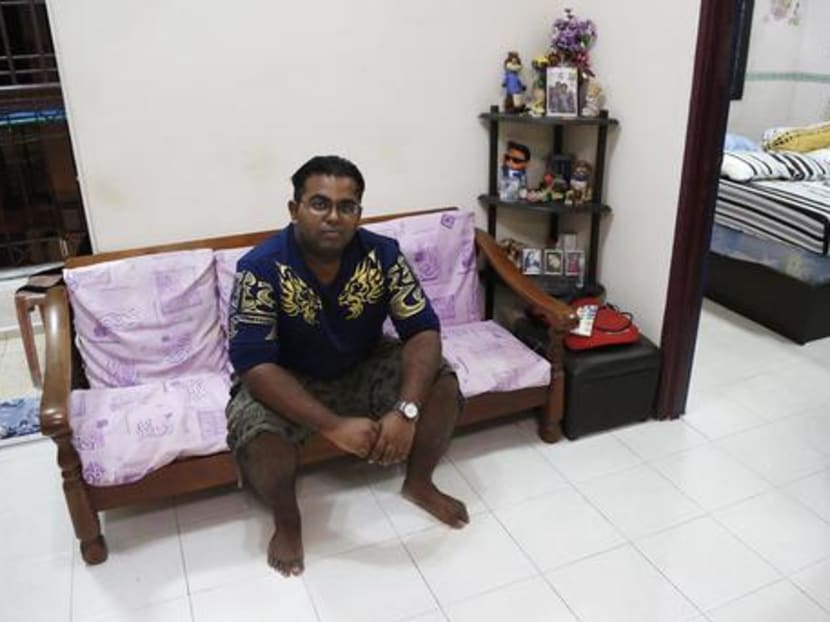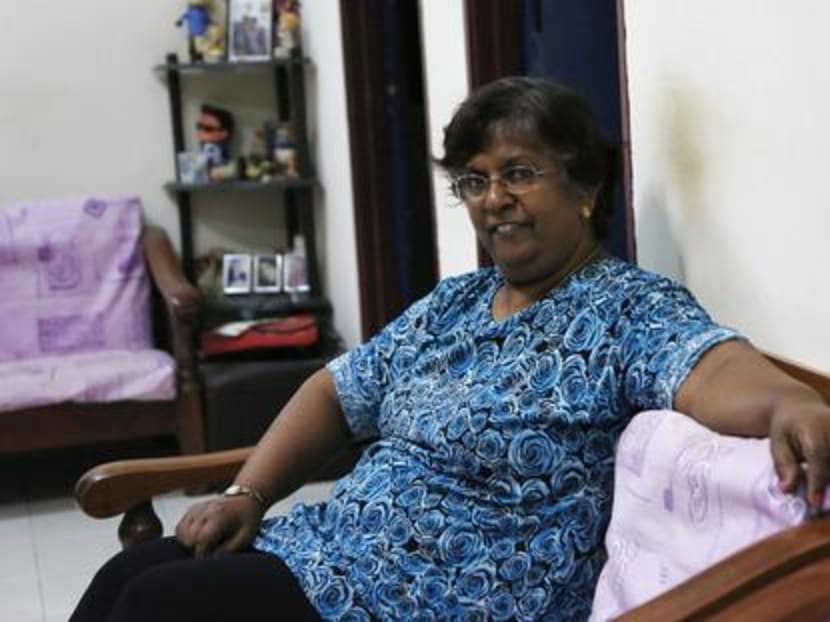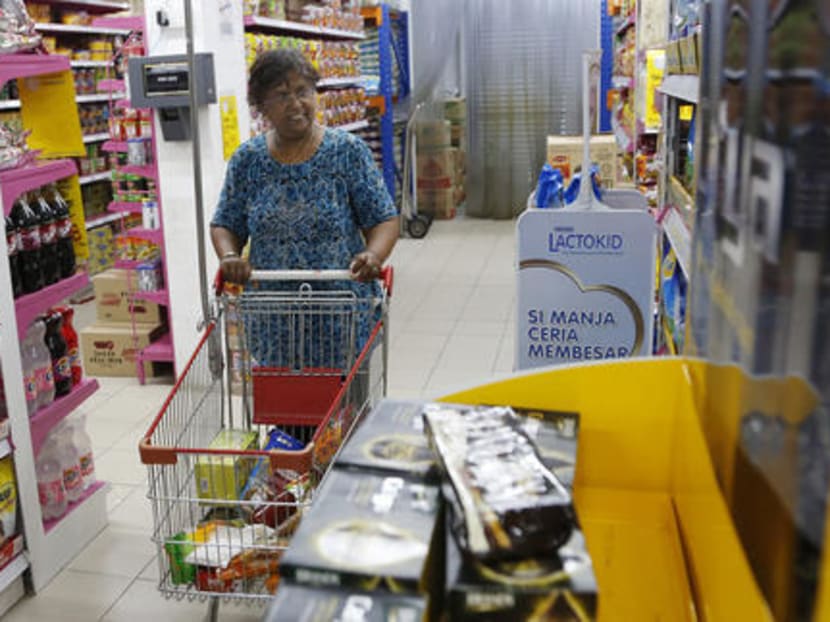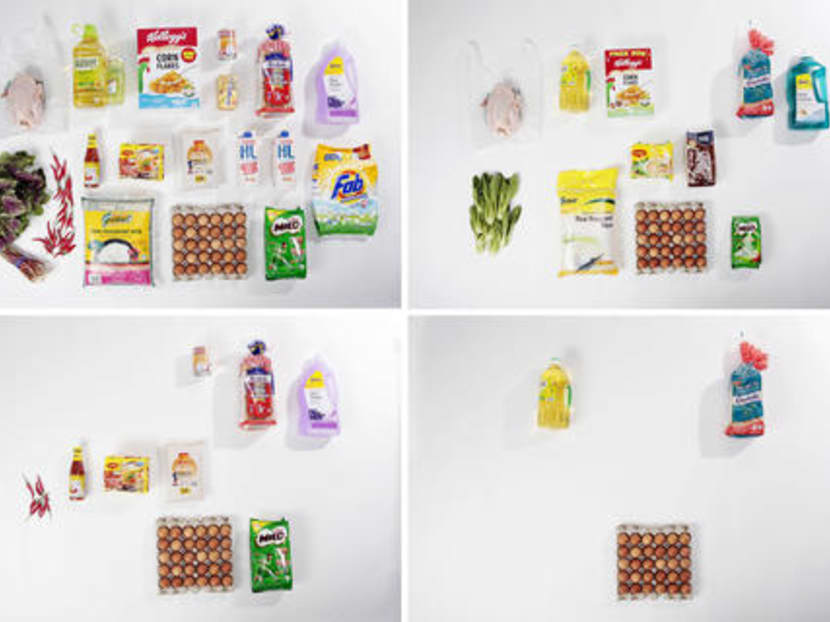Amid the ringgit’s slump, a tale of two families’ contrasting fortunes
SINGAPORE/JOHOR BARU — As the Malaysian ringgit continues to notch new lows against the Singapore dollar, TODAY looks at how the fortunes of two families have changed.

From left) Madam Vanaja Ramanathan (seated) with her sons Vasanthan and Logindran Balachandran in their rented flat in Singapore. The Anuar family who live in Johor: Erwin Isqandar Anuar, Madam Zainon Saini, Eleana Adriana, Mr Samsul Anuar, Edlyn Adriana. Photos: Raj Nadarajan/TODAY
SINGAPORE/JOHOR BARU — As the Malaysian ringgit continues to notch new lows against the Singapore dollar, TODAY looks at how the fortunes of two families have changed.
The Balachandran family
LIVING THE SINGAPORE DREAM
Mr Vasanthan Balachandran and his family used to have to think hard about stretching their 400 ringgit budget when shopping at the SongMart supermarket in the outskirts of Johor Baru.
Not anymore. These days, they just buy whatever they feel like, largely thanks to the Malaysian currency’s unprecedented slump against the Singapore dollar.

“We can just take a basket and drop everything we want. Life is sweet. Life is bling bling,” said the Malaysian, who earns about S$2,000 as a pre-boarding screening officer at Changi Airport.
The Singapore dollar continued its climb against the ringgit last week, hitting a new all-time high of 3.1786 on Thursday (April 13). The outlook for the ringgit – which has been on a downward spiral since mid-2014 due to the global oil price slump, a corruption scandal at state investment fund 1Malaysia Development Berhad and rising US interest rates – remains wobbly, especially with the continued outflow of capital from Malaysia since Mr Donald Trump’s election victory last November.
On the ground, the impact of these currency movements can be dramatic. For instance, Mr Vasanthan’s salary, once overtime pay and incentives are included, can now match that of a professor in Johor Baru.

It is a welcome change for the 31-year-old, who began working at the age of 18 transporting gas cylinders from house to house.
Financial pressures on Mr Vasanthan grew in 2008 after his father died of diabetes, and left him as the head of the household. Earning RM1,400 at most as a warehouse assistant, he struggled for a few years to keep his younger brother in school and the household afloat.
Three years ago, Mr Vasanthan began applying for accounting jobs in Singapore after hearing multiple accounts about the greener pastures across the Causeway. The diploma holder was repeatedly rejected by employers in Singapore.
While walking past the Certis Cisco building at Paya Lebar one day, however, he decided to walk in and ask if they were hiring. He was offered an airport security job with a basic pay of S$750 (worth RM1,900 then) on the spot.
He has been with the company since. His spending power began to grow significantly, thanks to a heady combination of a rise in his Singdollar-based salary and the ringgit’s slump against the Singapore currency.
In 2015, for instance, he and his 25-year-old brother, who also works in Singapore, felt financially secure enough to fork out S$1,250 a month to rent a three-room Housing and Development Board flat just so they could get more sleep and avoid the Causeway commute.
This is on top of the S$650 that they give their 62-year-old mother, who lives with them in Marsiling.

At the same time, they kept their flat in Pulai Jaya, a 30-minute drive from the Causeway, which they visit once every two weeks and pay RM400 a month for cable television subscription, phone and utilities.
Mr Vasanthan is even on track to upgrade his RM8,600 Yamaha FZ 150cc to his dream bike, a RM26,000 Kawasaki Ninja 250R, by the end of the year. All he needs is to make a down payment of RM5,000, followed by monthly RM400 installments.
With the weakening ringgit, his family can stretch their dollar even further when they spend across the Causeway.
Mr Vasanthan rides his motorbike to Johor Baru once every four days to get fuel. For RM20, he can get a full tank, which would cost about three times as much in Singapore.
His mother, Madam Vanaja Ramanathan, would save another S$10 by picking up groceries such as condensed milk, Lipton tea, bottles of kaya, soya, chili and tomato sauce, which cost no more than RM60.

Word about Mr Vasanthan’s new found spending power has gotten around. For one, he no longer gets a discount from his long-time mechanic.
The mechanic would in fact ask him: “You now work in Singapore right? Can tip?”
His Malaysian neighbours and acquaintances also eagerly ask him about job opportunities in Singapore. “Those working in JB, they treat like a normal person, those working in Singapore, they look to you like some big shot,” Mr Vasanthan said with a wry smile.
But he says he is fine with that, as long as he does not have to scrimp anymore.
“I am feeling more settled, confident and relieved... Whatever we want to buy, we can now buy. We are steady,” he added.
The Anuar family
SNOWED IN BY THE RINGGIT'S SLUMP
JOHOR BARU — Five years ago, the Anuars sold their three-room flat in Marsiling and relocated to Pulai Jaya in the outskirts of Johor Baru. They were next-door neighbours with the Balachandrans at one point.
But unlike Mr Vasanthan Balachandran who saw his spending power soar as the ringgit declined against the Singdollar, the Anuars were caught on the wrong side of the unprecedented currency movements.

Earning in ringgit while having to spend in Singapore, the family of five - four Singaporeans and a Malaysian - soon discovered how tough life could get as their spending power fell dramatically.
Mr Samsul Anuar, a bailiff at the Johor High Court, and Madam Zainon Saini, a Singaporean, married in 1995. They had to live apart for many years because the Malaysian civil servant could not get a social visit pass to stay in Singapore for more than 30 days at a stretch, despite five applications and appeals to their constituency’s Member of Parliament.
The couple coped as best as they could, but financial pressures on the family came to a head in 2012: It had simply become too expensive for them to live in Singapore on Mr Anuar’s RM3,000 salary.
It was also getting too costly for him to fork out S$20 (RM36 in 1995, RM50 by 2012) every week for the Vehicle Entry Permit (VEP) to enter Singapore to see his family.
Adding to the family's financial stress, Madam Zainon had to quit her S$1,200 a month (about RM2,900 then) security officer job in 2011 to tend to their sick daughter.
Madam Zainon said she felt the pinch even back then, when the exchange rate was about one Singdollar to RM2.40. “I shivered whenever it was time for me to open my letterbox. The bills could go up to S$170 a month (RM408 by 2011 rates),” she told TODAY.
Living in Johor Baru, they had to tighten their belts even though living expenses were more manageable.
Given just RM1,000 to manage the family’s expenditures, Madam Zainon shied away from buying even cheap shoes, handbags or clothing.
Their weekly visits to McDonald’s and KFC had to be reduced to two or three times a month, said the housewife. Shopping became a “just to see only” exercise for the children to eye what they like, so they can save up for it.
What became most unbearable, however, were the trips to visit friends and relatives in Singapore. With her husband’s salary shrinking in value from S$1,200 to S$950 due to the currency fluctuations, Madam Zainon and her children could no longer afford to spend a day in their home country without missing a meal.
“RM50 (S$15.80) is gone after you top up your EZ-link card and eat a meal. So sometimes, in Singapore, I say that I’ve already eaten when I haven’t. I eat when I return to Johor at night,” the 54-year-old said.

She supplements the family’s income by selling home-baked pineapple tarts and marble cakes. A bottle of 80 tarts retail for RM30 in Johor Baru. But in Singapore, she can sell them for S$30.
Raw ingredients also cost less in Malaysia. For example, a 500g block of butter cost RM10.77 (S$3.41) in Johor Baru’s Giant supermarket, compared to S$4.60 (RM14.50) in Singapore’s Giant.
She is eyeing another silver lining next year, when she turns 55. That is when she will start receiving payouts from her Central Provident Fund savings amassed from working in Singapore for more than two decades.
The payouts will go a long way for her family as they are denominated in Singdollars.
She and her husband, however, are pinning the family’s long term hopes on the prospects of their 21-year-old son securing a well-paying job in Singapore.
“My children still see a better future in Singapore,” said Madam Zainon.
RELATED STORY: Compare — what you can buy with RM50 and S$50 at a supermarket












